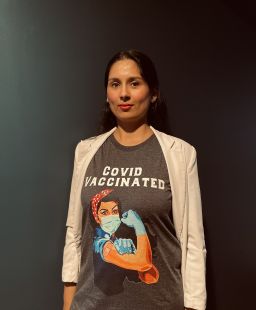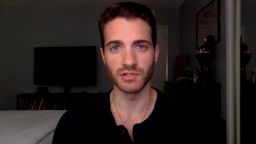Editor’s Note: Syra Madad, DHSc, MSc, MCP is an infectious disease epidemiologist, faculty at Boston University’s Center for Emerging Infectious Diseases Policy and Research, senior director of the system-wide special pathogens program at NYC Health + Hospitals and is currently responding to the monkeypox outbreak in NYC. She is also a fellow at the Belfer Center for Science and International Affairs. She tweets @syramadad. The views expressed in this commentary are her own. View more opinion at CNN.
For nearly two and a half years, Covid-19 has been center stage in the headlines. And still, this virus is not letting up. Our Covid-19 responses have been trying to play catchup. Health officials are now recommending second booster doses of vaccine for 50 and older and kids 12 and older who are immunocompromised, with the potential to expand eligibility to Americans adults under 50 years old as the latest BA.5 variant takes a foothold.
Now, another infectious disease threat is also taking over headlines: monkeypox.

Unlike Covid-19, which was completely new to humanity and spread to 114 countries and territories in a matter of months, monkeypox is a decades-old virus that has caused sporadic outbreaks in Western and Central Africa since its discovery in humans in the 1970s. In fact, the Democratic Republic of Congo sees upwards of thousands of cases of monkeypox every year.
Here in the US, we are finally paying attention to monkeypox because it’s spreading within our own borders – with reported cases topping 2,000, according to the US Centers for Disease Control and Prevention – and causing an unprecedented global outbreak.
Recent data from New York City shows that about 98% of reported monkeypox cases are among men and 2% among transgender, gender nonconforming and nonbinary individuals. Almost all are men who have sex with men (MSM).
There is nothing intrinsic to the monkeypox virus that makes it spread specifically to the MSM community, but engagement with the highly interconnected sexual networks of the MSM community has become a risk factor for the virus. All outbreaks start somewhere and, unfortunately, monkeypox has found a footing into the MSM social network.
The primary way monkeypox spreads is through close skin-to-skin contact, and sex is one activity that necessitates such contact. But the reality is that anyone can get and spread monkeypox.
The difficult truth is that this monkeypox outbreak could have been avoided. We should have paid attention to this virus decades ago. Turning a blind eye to an outbreak happening in another country is not only foolish – it’s dangerous.
We are fortunate that the US has FDA-approved vaccines to prevent the spread of monkeypox and is actively working to scale up and deliver more doses to mitigate new infections, as well as therapeutics to lessen disease severity (though access to both vaccines and the antiviral drug tecovirimat remains a challenge).
Monkeypox testing capacity is also ramping up with at least five commercial laboratory companies on board so far to handle samples, increasing the nation’s testing capacity from the initial 6,000 specimens a week at the start of the outbreak in May to 80,000 per week now, according to the CDC.
So, with these resources on hand, why is the US not able to contain the monkeypox outbreak?
The answer is much more complex than just a few mishaps; it is a combination of an initial narrow criteria for whom to test for monkeypox sent to a limited testing infrastructure of public health labs, challenges with doing contact tracing for multiple or anonymous sexual partners, a vaccine supply that has fallen far short of demand, lack of resources to support self-isolation of people that are positive and our tiptoeing around communicating the reality that the most at-risk population is men who have sex with men. Adding to this already calamitous situation, we are reliant on decades-old clinical information to inform our understanding of this disease, while the current outbreak is showing unusual disease presentation with atypical features.
The fact is that the US, and the world for that matter, is just bad at responding to infectious disease outbreaks.
Our emphasis on preparedness (knowing that an outbreak will occur and trying to mitigate or lessen its impact by way of things like vaccines and therapeutics) over prevention (stopping the outbreak from occurring in the first place) says a lot. If I had a jar of coins for the number of times I’ve heard or read the term “pandemic preparedness,” I’d be a rich person.
Just look at the 2019 Pandemic and All-Hazards Preparedness and Advancing Innovation Act, which aims to improve the nation’s preparation and response to public health threats. It mentions the word preparedness 142 times but the word prevention 3 times in context.
Luckily, this is starting to change. With harsh lessons learned from the Covid-19 pandemic, there is now greater emphasis on prevention. In March, the Senate Committee on Health, Education, Labor and Pensions passed the PREVENT Pandemics Act to prepare for, and respond to, existing viruses, emerging new threats and pandemics. The Biden administration is also investing in preventing biological catastrophes by allocating almost $90 billion for fiscal year 2023 – all steps in the right direction.
Prevention should be the gold standard, but preparedness is essential since prevention is not always possible – especially given geopolitics, human behavior, varying surveillance capabilities and, importantly, ability to detect and honestly report at the local level.
Time is of the essence. One of the biggest lessons learned from the Covid-19 pandemic is that we need to be fast, be ready and have a plan of action at our fingertips. From the time the US detected its first case of monkeypox on May 18, it took one month for the CDC to activate its emergency operations center to support the agency’s monkeypox response, one month for the US Department of Health and Human Services to announce its enhanced nationwide vaccination strategy to mitigate the spread of monkeypox and nearly two months to increase testing capacity across the nation to detect cases.
While monkeypox is not likely to pose a significant health threat to the general US population at this time, the current level of transmission coupled with a patchwork of response capabilities is most concerning. Threat levels can change as the virus spreads to more places and more people.
There is a small window to contain local outbreaks before they grow to pandemic levels. That window for monkeypox containment is closing on the US quickly, with some public health experts already saying the window has likely closed and the monkeypox virus is here to stay.
This is just another example of how a localized outbreak, without adequate global attention and resource support, has spread throughout the world. Regardless of the messaging coming from health officials, monkeypox is a pandemic according to the CDC’s definition, which defines a pandemic as “an epidemic that has spread over several countries or continents, usually affecting a large number of people.” While the label is more about semantics, it’s the actions that count.
We must act fast, and we must act now.





